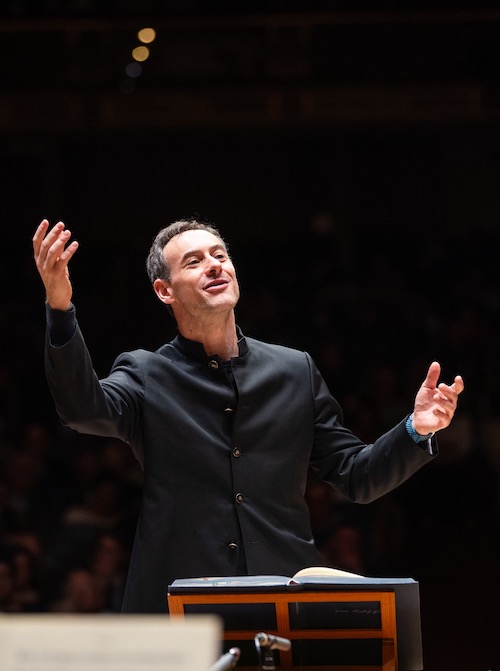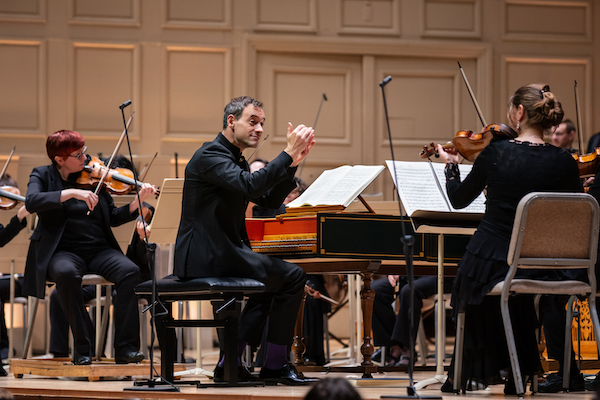Cohen launches Handel & Haydn tenure with a majestic “Israel in Egypt”

Jonathan Cohen conducted the Handel & Haydn Society in Handel’s Israel in Egypt Friday night at Symphony Hall. Photo: Robert Torres
Just like that, Boston’s heavyweight classical musical ensembles are both back in action: one day after the Boston Symphony Orchestra kicked off its 143rd season, the Handel & Haydn Society followed suit, opening its 208th at Symphony Hall.
If Friday night’s concert had a special vigor to it—and it did— that was because it marked the beginning of Jonathan Cohen’s tenure as the group’s new artistic director. The 45-year-old Englishman continues a trend of youngish, UK-born musicians being given the reins of the United States’ oldest performing arts ensemble (its last American-born leader was Thomas Dunn, who stepped down in 1986).
Given the charismatic Cohen’s obvious rapport with the ensemble in his appearances last season, one expects big things from this appointment. Friday’s majestic performance of George Frederic Handel’s oratorio Israel in Egypt didn’t disappoint.
Handel’s score, written in the course of a single month in 1738, shares more than a few stylistic and structural traits (as well as librettist Charles Jennens) with Messiah, which was composed three years later. Its narrative follows, somewhat choppily, the biblical account of Israel’s miraculous deliverance from captivity in Egypt.
The work’s most famous music are the choruses in Part 2 during which Handel evocatively depicts the ten plagues visited on Israel’s oppressors. But there are several striking arias and duets that dot the work, too, including Part 1’s lilting “What though I trace each herb and flow’r” and Part 3’s “Toss’d from thought to thought I rove.”
On Friday, all the solos were sung by members of the H&H Chorus. Soprano Teresa Wakim’s shining delivery of the word “herb” in the aforementioned number (an awkward bit of English text-setting, if ever there was one) spoke as impressively as did her tasteful embellishments of the aria’s repeated first half.
Baritone Woodrow Bynum imbued the climactic phrases of “To God, our strength, sing loud and clear” with a resonant sheen. Meanwhile, “Their land brought forth frogs,” was dispatched with charming lightness and agility by countertenor Douglas Dodson, who also seemed to take conspicuous pleasure enunciating that air’s rarely heard references to “blotches and blains.”
Basses Ryne Cherry and Craig Juricka proved well-matched and aptly vigorous in their duet “The Lord is a man of war,” while tenor Steven Wilson delivered a bright-toned, energetic account of “The enemy said, I will pursue.” Capping everything was soprano Sonja DuToit Tengblad, whose injunctions (sung from the middle of the choir) to “Sing ye to the Lord” soared radiantly.
Unsurprisingly, the larger choral contributions were fervent, precise, clearly enunciated, and impeccably blended. The plague choruses in Part 2 came over vividly, especially the sequence of pummeling hailstones, sepulchral darkness, and the slashing depiction of the Egyptian firstborn being slaughtered.
But it was in the oratorio’s outer choruses that the group proved most impressive. The opening “Your harps and cymbals sound” was the picture of dancing, limber counterpoint. And Cohen shaped the concluding “Sing ye to the Lord” with a musical wisdom that belied his youth: every voice in this vigorously polyphonic music seemed to speak and fall exactly where it should.
The conductor led the orchestra from the keyboard, which resulted in the unusual sight of two harpsichords set up on stage, front-to-back. The outcome was hardly a jumble: Ian Watson, H&H’s resident keyboardist, anchored the continuo and did double duty here and there on organ, while Cohen periodically joined him to reinforce the instrumental fabric.
If that made for an occasionally busier-than-usual texture, the arrangement had no discernibly negative effect on either the orchestra’s sonority or its engagement with the music’s dancing line. Indeed, Friday’s performance was spirited, lilting, colorful, and shapely Handel. That was especially true of the accompaniments to the plague choruses, with their sinking figures depicting water turned to blood, swirling scales illustrating swarms of flies and locusts, and ominous swells conjuring the terrors of darkness.
But it was the parting of the Red Sea that highlighted an instrument one doesn’t always consider an orchestral soloist. Yet so vigorous and effective were Jonathan Hess’s timpani attacks in the roiling “He rebuked the Red Sea” that one felt he and H&H would be up to attempting that feat on their own.
The grandeur of Friday’s performance was somewhat marred—though thankfully not derailed—over the night’s first half by some of the most appalling cell phone etiquette (or lack thereof) at Symphony Hall in recent memory.
In addition to several people in the front of the hall distractingly videotaping the concert, no less than five phones went off during Parts 1 and 2. In the luftpause between the choruses of hailstones and thick darkness, a woman a couple of rows behind me actually answered hers and started having a conversation—on speakerphone. The Angel of the Lord (or some other entity) must have intervened during intermission because Part 3 unfolded, blessedly, sans electronic disturbance.
The program will be repeated 3 p.m. Sunday at Symphony Hall. handelandhaydn.org
Posted in Performances
